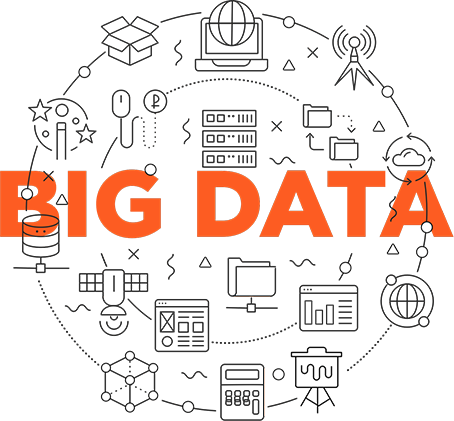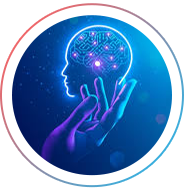Big Data Insights












What is Big Data?
Big Data is like an umbrella phrase that mentions the huge availability of both prearranged and formless data as well as its rapid expansion. Although at first glance the phrase might appear to relate to the amount of information, it understands both the data that is revolving and several tools and measures that an organization needs so that to manage such huge data and storing needs.
Why Big Data is Important for Companies?

Big Data is a topic that everyone is talking about right now, from the issues that it offers necessary technology that is necessary for Big Data initiatives. Companies are becoming aware that investing in Big Data infrastructure could assist them in producing better judgments. Organizations acquire a clear and full picture of their company that Big Data stands for is properly and efficiently chronicled, handled, and analyzed. This might lead to gains in efficiency, decreased expenses, greater sales, and improved customer service. The usage of analytics methods like ML, data mining, NLP, and statistics is needed for the giving out of Big Data.
For instance, businesses may modify their product offers and marketing methods by investigating the customers' buying habits and preferences. Big data analytics services allows medical professionals to better recognize tendencies in patient data, which leads to more accurate diagnosis and treatment options. By evaluating data received in actual time from sensors that are implanted in its manufacturing equipment, manufacturers may improve the efficiency of the retail chains and production procedures.
A Short History of Big Data
The history of how data got so significant begins a long time ago, well before the recent frenzy all through the big data. Already somewhere 60 years back, we came across the initial efforts to measure the increase rate in the amount of data, or what has been commonly known as the "information explosion." This phenomenon has been called "the digital revolution."
John W. Tukey, a statistician who was born in the United States, is known to be the initial pioneer in this phase. In 1947, he who did propose the concept of analysis based on exploratory data. Tukey placed a strong emphasis on the need of reviewing data groups to discover trends and correlations, so laying the groundwork for future developments in data analytics.
The discipline of management in data started to take form in the 1960s, at the same time when computers became more readily available and were able to analyze bigger volumes of data. One of the first examples of database organization software, IBM's Information Management System (IMS) was one of the first programs of its kind to be made to handle massive volumes of data.

The term 'big data' dates back to the beginning of the 1990s. Though it's not precisely who originally understood the word, the majority of the credit goes to John R. Mashey, who was employed at Silicon Graphics during the relevant period with popularizing the term. We continually create data variety of forms, such as texting, imageries, videos, and a variety of additional formats, as a result of the growing number of devices that are linked to the net, like smartphones, wearables, and IoT devices.

During this period, Mike Cafarella as well as Doug Cutting created Apache Hadoop, which was an open-source software architecture that allowed for the dispersed handing out of huge datasets distributed among groups of machines. Hadoop was an innovation in the big data industry since it allowed organizations to hold, process, and analyze huge amounts of data in a way that was both productive and advantageous. This was made possible by Hadoop's distributed file system (HDFS).
The growing number of social media platforms in the early 2000s added further to the big data revolution. The quantity of user-generated material that was created on websites such as Facebook and Twitter was immense. This content included messages, responses, and interactions. This social data quickly became an invaluable resource for companies that wanted to get a better understanding of the behavior and preferences of their customers. Big Data is now a well-established knowledge area, both in academia and in business.
Tracing the early years of Big Data
There is no doubt that Big Data has revolutionized the way we use information. Historical data has been recognized primarily as information that is ‘mined’ by organizations and companies to move forward for centuries. During the modern era internet has been instrumental in its paradigm shift to a more structured and refined utilization. Along with the help of advanced technology like Artificial Intelligence, Machine Learning, analytics, predictive modeling, and applications, the advantages are limitless. The impact currently it brings to organizations is amazing. It is this stage of the early years of big data that brings us to the latest mammoth era.
Exponential growth since the 1990s
The term ‘Big Data’ was first used by John R Mashey (Silicon Graphics). Its historical perspective now combines the maturity of two domains (Statistics + Computer OS). The techniques involve excellent knowledge and deep insights related to statistics, math, and data analysis.
Timeline overview
By the end of 2023-2025, it is said that big data will multiply to over 180 zettabytes due to the explosion of connected devices.

Hollerith Tabulating Machine is created to manage big data

A lead towards data storage in the next 100 years.
Magnetic data storage tape developed by A German-Austrian Fritz Pfleumer

A base which emerged for today’s infrastructure to collate information
Structured data introduced by Shannon’s Information Theory

30 years later an explanation by Mathematician Edgar F Codd (IBM) how remote access to data will become the mainstay.
His theory of ‘Relational database’ becomes integral to large databases for those who have deep computer knowledge.

World Wide Web is created by Tim Berners-Lee

The largest data storage set is created by Hadoop open-source platform
Big Data becomes a larger term

Research paper shows how companies are using Big Data to grow
Big Data is recognized as the Game-changer ‘for fueling growth.

Obama Administration agrees to the Development Plan that benefits from information.
Benefit to the masses and economy.

Companies having unstructured data need to make legacy changes.
Push to all firms who need to utilize and mine information for growth.

Nearly 59% of companies move towards predictive modeling to modernize.
The way business is done online is transforming.
The Basics: Big Data
Big data privacy concern: The notion of "big data" has evolved as a useful tool for organizations to get important insights and make educated choices as the world continues to become more computerized. However, with tremendous power comes great responsibility, and the privacy risks that are linked with big data cannot be ignored.
In response to these concerns, regulatory agencies and governments have enacted rules and regulations to protect the private rights of people. For instance, the General Data Protection Regulation (GDPR) that was passed by the European Union gives people a greater degree of control over their data by establishing stringent criteria for the collecting, processing, and storage of data.
When it comes to matters of privacy and big data, companies have a responsibility to implement appropriate procedures. This requires gaining informed permission from people before collecting their data, anonymizing or de-identifying data wherever it is practicable, and adopting stringent security measures to defend against unauthorized access or data breaches.

Big Data Concept
The concept of Big Data refers to the vast and complex sets of data that are characterized by their volume, velocity, and variety. It encompasses the collection, storage, analysis, and interpretation of large amounts of data. In contemporary society, computers have emerged as a dominant technology, supplanting traditional manual registers due to their capacity for large-scale data storage.

In the contemporary day, there is a discernible trend toward globalization, which is also reflected in the increasing interconnectedness and interdependence of individuals and societies. In the present day, search engines and social media platforms are seeing a substantial influx of data from many sources worldwide, including records, information, and statistics.
This phenomenon is often referred to as Big Data. Hadoop is a framework designed for the processing and analysis of large-scale, unstructured, and intricate datasets. We are obtaining substantial information from many sources such as social networking platforms, Walmart, the finance department, and so on. The magnitude of the quantity is very substantial where conventional storage technologies are unable to accommodate it.
We Deliver Big Data Insights Services Across
Categories of Big Data
Consequently, big data qualities may be described by five distinct dimensions, sometimes referred to as the five Vs. Such attributes do facilitate the interpretation of large datasets but also provide insights into managing vast, uneven data at a manageable pace within a reasonable timeframe. It enables the extraction of valuable information, conducting actual time analysis, and rapid responsiveness.

Volume
The term "volume" is known as the magnitude of the data generated and retained inside a Big Data framework.

Variety
Variety encompasses the diverse choice of data kinds that exhibit variations in their formats and organization, hence influencing their suitability for processing.

Velocity
The velocity of data accumulation plays a significant role in determining the classification of data as either big data or regular data.

Value
The consideration of value is an additional significant topic that merits attention. The significance of data extends beyond its quantity, including both storage and processing aspects.

Veracity
The term "veracity" pertains to the reliability and excellence of the information. The indisputable usefulness of Big Data persists in cases when the data lacks trustworthiness and reliability.
How Does Big Data Work?
The "Big Data" may be broken down into both unstructured and organized categories. Information that has been previously managed by the organization in spreadsheets and databases is referred to as structured data. Structured data often has a concentration on numerical information. Unstructured data is information that is not organized and does not fit into a specified model or format. This kind of information does not conform to a standard. It incorporates information obtained from sources related to social media, which helps organizations understand more about the needs of their customers. Many additional storage and processing information technologies are now available.
Some examples of these tools are NoSQL databases such as MongoDB and two of them columnar databases such as Apache Parquet, and distributed stream processing / like Apache Kafka. As a direct consequence of this, businesses operating in a wide variety of sectors, such as healthcare, banking, and e-commerce, depend significantly on computer databases to preserve and manage the priceless information assets they own. Not only can the usage of computer databases help operations run more smoothly, but it also helps organizations to make more informed choices.
The workings of big data go through several stages, beginning with the collection of data and continuing through cleaning, preprocessing, and analysis.

Data Collection
The practice of gathering information from clients, either directly or indirectly, is known as data collection. Different types of companies each have their unique approach to this. These may be collected through reviews, social media, polls, volunteers, prior purchase data, and a variety of other methods.

Data Pre-Processing
Data pre-processing is the step of the whole analytics process in which the data that has been acquired or the raw data is turned into well-ordered data sets to achieve a better level of accuracy. At this point, it is checked to make sure that the modified data does not include any missing information.

Cleaning Of Data
Scrubbing the data is necessary for improving the data quality and achieving better outcomes, and this is true regardless of the amount of data. At this point in the process, the data are formatted in the same context, and any unnecessary or duplicate data are removed from the system.

Data Analysis
At this point in the process, the data that have been acquired are transformed into insights. Data mining, predictive analytics, and deep learning are examples of some of the most prominent ways of doing data analytics.
Life-Cycle Phases of Big Data
The many phases of the Big Data life cycle may provide a comprehensive understanding of its overall process. This implies that all acquired information and insights derived from data analysis may often be used by big data developers for subsequent tasks.
Generation
The process of generation occurs subconsciously. Both people and organizations consistently provide data. All online interactions, transactions, and exchanges generate digital footprints. This is the point at which the transformative potential of Big Data becomes evident. When data is given proper attention and subjected to appropriate analysis, it has the potential to provide valuable information for those capable of using and interpreting it.
Collection
Not all data has use for further analysis within the context of Big Data. Due to this rationale, not all data created daily is gathered or used. The responsibility for determining the specific data to be collected and the most effective methods for its acquisition lies with the experts in the field of Big Data. There are several methods through which it may be accomplished.
- Forms: Big Data, forms with relevant data are useful sources.
- Surveys: Surveys can efficiently gather a lot of data through many individuals.
- Interviews: Interviews enable quantitative and subjective data collecting that would otherwise be difficult.
- Data Observation: Seeing individuals use a website or app.
Processing
After the collection of all data has been completed, it is necessary to undergo the process of data processing. The process of Big Data processing occurs in the following manner:
- In this particular instance, a collection of data undergoes a process of cleansing and transformation, resulting in the creation of sets that possess enhanced accessibility and use.
- In the current phase of the Big Data lifecycle, the process of data compression involves converting data into a format that enables more efficient storage.
- Data encryption is a process wherein data is transformed into an alternative code to safeguard its confidentiality.
Visualization
After the completion of data analysis, the subsequent step in the realm of Big Data involves the use of data visualization techniques.
Interpretation
The process of interpretation is of utmost importance in comprehending the meaning and relevance of data. The process encompasses more than just examination of the quantitative figures or objective information; it requires a meticulous depiction and elucidation of the real insights derived from the data.
Big Data Frameworks
Apache Spark ![images]()
It is a robust open-source platform that offers a range of processing capabilities, including real-time stream handling, interactive manufacturing, graph processing, memory processing, and batch processing of data. It excels in terms of its high speed, user-friendly interface, and adherence to established protocols.
MongoDB ![images]()
MongoDB is a versatile database management system that may serve a wide range of functions, including but not limited to logging, analytics, ETL (extract, transform, load), and machine learning (ML) applications. The storage of a large number of documents may be accomplished without concerns about performance-related challenges.
Hadoop ![images]()
Hadoop is designed to empower enterprises and augment their skills. The system can effectively manage vast quantities of data. Furthermore, it has shown success in several sectors.
Apache Hive ![images]()
The installation of Apache Hive requires a pre-existing installation of Apache Hadoop since Hive is an integral component of the Hadoop ecosystem. The scripting syntax in Hadoop is quite straightforward to implement in comparison to Java Map-Reduce.
Big Data Challenges
The procedure of preserving and analyzing a vast quantity of information on a variety of data storage is one of the Big Data Challenges. Another one of these challenges is determining the most effective method for managing enormous amounts of data. During dealing with it, one is faced with several significant obstacles of a significant kind, all of which have to be overcome with quickness.
The lack of knowledge among professionals is a concerning issue that can have significant consequences in various fields. Whether it is in healthcare, education, or any other industry, professionals are expected to possess a certain level of expertise and knowledge to effectively carry out their responsibilities. However, there are instances where professionals may lack the necessary knowledge, either due to outdated practices, insufficient training, or simply being ill-informed. This can lead to ineffective outcomes, errors, or even harmful consequences for individuals seeking assistance.
When working with the data, ensuring that it is accurate is of the highest significance. In the end, every nugget of wisdom you extract from data is going to be dependent on the data itself. The phase in which data are collected is where everything gets started. If you want to use the data later on for outputs, you need to ensure that you are collecting it at the appropriate time from the appropriate sources.
The quality of the data will be determined not only by the gathering of the data but also by the method through which the data is stored. For it to be analyzed, it first has to be made available; here is where solutions that include automation come into play.
During the data lifetime, you are responsible for appropriately maintaining the data so that it may be used by the appropriate team for application at any point in time. Utilization of this data is what ultimately leads to improved decision-making skills.
It is easy for decision-makers to feel overwhelmed by the sheer amount of big data technologies that are now available on the market, which may lead to misunderstanding and hesitancy. It is essential to first determine the particular demands and objectives of the company before attempting to traverse this complicated terrain. When trying to limit the alternatives, it is necessary to have a solid understanding of the amount, variety, and velocity of the data that will need to be processed. Additionally, taking into account the knowledge and skill set of the data team may assist in aligning the process of selecting tools with the resources that are at one's discarding.
Complicated data collection is often more difficult to prepare and analyze than simple data, and it frequently will need a different set of BI tools to do so. The complexity of your data is likely to predict the amount of difficulties you'll experience when attempting to transform it into business value. Before complex data may be "ripe" for analysis and visualization, more work must be done to prepare and model the data. This effort can be time-consuming. To determine whether or not your business intelligence project will be up to the challenge, you must first have an understanding of the existing complexity of your data as well as the prospective complexity that it may exhibit in the future.
You may discover areas in which vulnerabilities and dangers are hiding and find any gaps in your processes by comparing them to the best practices in the industry and comparing them to your practices. But a security gap analysis does more than that; it also provides you with the appropriate organizational structure and control mechanisms to follow the recommendations it provides. Individuals and organizations may reduce the likelihood of being subjected to a cyber assault, safeguard their assets, and preserve the faith of their stakeholders if they take the initiative to identify and fix any security flaws that may exist.
It is very necessary to interact with numerous data sets in today's complicated corporate world, as information floods in from a variety of different places during the day. It is challenging to manage data that is dispersed over several different spreadsheets, such as Excel or Sheets, business intelligence systems, internet of things devices, cloud platforms, and online apps. The procedure often necessitates the participation of specialists in information technology, data analysts, and subject matter experts, which contributes to an increase in both the total cost and the time invested. Integrating different types of data might also result in problems with the data's quality.
The lack of skilled workers is a critical problem that is affecting businesses and economies all around the globe. Employers are facing the issue of finding suitable applicants to fill important tasks as a result of the ongoing reshaping of the work market that is being caused by technological improvements. This scarcity may be linked to several different issues, including fast technology improvements that are outpacing the development of necessary skills, demographic trends that are contributing to an older workforce, and a lack of investment in education and training.
Real-World Applications of Big Data in Various Industries
In recent years, "Big Data" has emerged as a popular term, yet its influence extends much beyond the scope of a mere catchphrase. Big Data has transformed a variety of different businesses by delivering invaluable insights and propelling the process of decisions. Let's investigate some real-world uses of Big Data that span a variety of industries.

The arts and entertainment industries
In today's digitally-driven economy, analyzing large amounts of data is essential to both earning more income and giving customers more tailored experiences. Big data is used every day by companies like Hulu and Netflix to study user habits, favorite content, consumption patterns, and a great deal more. These companies work with massive amounts of data. Netflix employed predictive data analysis to develop their program House of Cards since the data confirmed that it would be a hit with customers. This allowed Netflix to design a show that consumers would like to watch.
Have you ever pondered the reasons for the proliferation of streaming services? This is because big data is revealing new methods to commercialize digital material, hence offering new income streams for organizations that specialize in media and entertainment. Because of analytics software, advertisements are now targeted more strategically. This enables businesses to have a better understanding of the effectiveness of advertisements depending on the characteristics of certain sorts of customers.

Transportation
Big data has established itself as a significant game-changer in the field of transportation. Transportation systems are producing enormous volumes of data every day as a result of technological advancements and the growing prevalence of the usage of sensors and other devices. This information, which is often referred to as "big data," has the potential to completely transform how we comprehend and improve the functioning of transportation networks. Transportation planners and engineers may acquire significant insights into traffic patterns, congestion hotspots, and travel behavior via the analysis of this data. Analytics have made it possible for us to have complete faith that Google Maps will get us where we need to go with the least amount of effort and the greatest amount of ease.

Healthcare
Having access to healthcare is very important for both people and communities, as it provides prompt medical treatment and interventions, which ultimately leads to better health outcomes. As a result of the everyday collecting, storage, processing, and analysis of enormous amounts of data, data have evolved into an all-pervasive idea in our day-to-day life. This quality applies to a wide variety of fields, spanning from the study of machine learning and engineering to the fields of economics and medicine. In addition, healthcare encompasses not only the treatment of sickness but also the education of patients, the avoidance of disease, and the promotion of behaviors that are beneficial to a healthy lifestyle.

Finance and banking
Banking and financial services are very important to our day-to-day lives because they provide a variety of services that assist us in arranging our finances, doing business, and making preparations for the future. The buying habits and other activities of credit cards are monitored by banks so that any unusual movements or abnormalities that may be indicative of fraudulent transactions may be identified. Analytics provide financial institutions with the ability to monitor and report on key performance indicators (KPIs), as well as personnel actions. A better understanding of how to turn prospects into customers and encourage higher use of different financial products may be gained by financial institutions via the analysis of data gleaned from the use of their websites and transactions. Banks employ Big Data to develop detailed profiles of individual customer lives, interests, and aspirations, which are subsequently used for micro-targeted marketing campaigns. These profiles may then be used for a variety of marketing things.

Cybersecurity
Leveraging the power of big data is vital for efficient threat detection and prevention in the dynamic and ever-changing environment of cybersecurity. This enables enterprises to remain one step ahead of hackers and helps them maintain their competitive advantage. Every time a new piece of software or hardware enters the market, there is certain to be a slew of accompanying security flaws and vulnerabilities. As previously unimaginable quantities of data are being created in a variety of formats at unpredictably high rates, security has unquestionably evolved into a shifting target. Data analytics enables automatic surveillance and threat detection systems, which in turn provide immediate alerting and continuous monitoring of the surrounding

Education
The analysis of large amounts of data gives teachers the ability to ascertain the subject areas in which their pupils excel or struggle, to comprehend the specific requirements of each student, and, as a result, to devise methods and provide assistance with the creation of individualized educational plans to facilitate effective learning. The acquisition and dissemination of huge amounts of data about each form have become an essential component in the formation of the modern social group. This is true whether one views this as a positive or negative development. Traditional approaches to student management and education are ineffective and prohibitively expensive. As the use of big data becomes more prevalent in the field of education, educational administrators and instructors are coming up with innovative strategies to foster the development of their students while also making more efficient use of their available resources. When educators use this preventative approach, they can identify children who may be in danger of falling behind and provide them additional help before they go too far behind.

Government
The analysis of large amounts of data may be of assistance to governments in a variety of different ways, including boosting public safety and security, improving healthcare systems, and making the most of urban planning. The use of big data contributes to the solution of national problems such as terrorism, unemployment, and the discovery of energy resources, amongst others. Typically, they monitor a variety of information and databases about the cities, states, population growth, energy resources, topographical surveys, and so on.
Benefits of Big Data
Big data helps strengthen marketing initiatives in addition to informing businesses about the present requirements and satisfaction levels of customers. Marketing strategies that are personalized are an efficient approach to attracting and engaging prospective consumers, which ultimately results in more leads being converted.
Reduce Operational Expenses
Big data provides insight into operations and enables you to monitor what's going on at your company at any given moment. The data collected by sensors are used to monitor and improve how assets, resources, equipment, and places are used.
Machine maintenance may be taken to a whole new level with the help of predictive and preventative analytics, which can spot faults before any symptoms appear. This will allow you to decrease waste, better distribute resources, and cut down on expensive downtime.
For firms that are looking for methods to reduce costs while making the most of the resources they have available, this is one of the most beneficial aspects of using big data.
Customer Acquisition and Retention
Inaccuracies and inconsistencies in the integrated data might occur as a result of discrepancies in the formats, naming standards, or data structures that can exist when combining data from many sources. When making decisions or conducting analyses, this may have significant repercussions because relying on inaccurate data might result in wrong findings or an unwise strategy.
The most recent big data procedures monitor the behaviors of customers. They then utilize those patterns to activate brand loyalty by gathering additional data to detect new trends and methods to keep consumers happy. This allows them to find more ways to satisfy the needs of their customers.
Innovative Products
These days, customers' lives can be improved in extremely unique and exciting ways because of the processing power that algorithms bring to Big Data. The beating heart of the development is innovation, and it is through the creation of the best goods that we can push the limits of what is now considered conceivable. Innovative items have the potential to revolutionize our lives and enrich the experiences we have daily.
These products may range from ground-breaking technologies to ground-breaking designs. Furthermore, these creative solutions are assisting firms in overcoming issues connected to storage, handling, and protection. This is opening the way for big data management methods that are both more efficient and safer.
Improving Both Customer Service
Helpline and technical support services that are driven by big data, machine learning (ML), and artificial intelligence (AI) have the potential to significantly increase the level of response and follow-up that businesses can provide to their customers.
Because firms can customize their outreach to specific customers as a result of the responsible use and analysis of customer and transaction data, there is a direct correlation between increased engagement with brands and more gratifying user or buyer experiences.
With the help of Big Data, businesses can develop individualized marketing strategies and make use of focused marketing, which in turn leads to higher levels of consumer satisfaction and loyalty.
Fraud and Anomaly Uncovering
Identifying fraudulent activity as well as anomalies is an essential component of today's security systems and algorithms. The likelihood of fraudulent operations occurring concurrently with the proliferation of online transactions and digital platforms has multiplied dramatically in recent years.
The combination of artificial intelligence and machine learning with large amounts of data makes it possible for these systems to readily discover fraudulent activity indications, erroneous transactions, and oddities in data sets that may lead to a variety of current or future problems.
Acquire and Keep Your Current Clientele
The analysis of large amounts of data may help you win over new consumers and strengthen the loyalty of your existing ones. The analysis of data will provide you with invaluable insights into the requirements and preferences of your clients.
The present level of customer happiness may be determined via the analysis of big data by businesses, which can also reveal areas in which a company can improve its ability to please its clients.
Big data can even grasp shifting patterns and foresee the behavior of customers, allowing businesses to continue to provide the highest level of service to their clients.
Top Big Data Trends
Because of the beneficial effects that big data and analytics have on businesses, these companies need to remain current with all of the most recent developments in this industry. We see a variety of firms that are using big data trends in various ways, but their basic objective is usually the same: they want to uncover new possibilities or strengthen their current business models so that they can continue to be competitive in today's rapidly changing world.
The discoveries that machine learning may assist scientists in making are not without a price. The processing capacity that is necessary for these algorithms takes vast quantities of energy, and many members of the geoscience community are asking for ever more powerful supercomputers.
It gives computers the ability to analyze enormous volumes of data, recognize patterns, and either make predictions or carry out actions depending on the analysis they have performed. There are many distinct kinds of machine learning algorithms, and each one is best suited for a certain kind of work or set of data. Businesses and academics can leverage the potential of machine learning to promote innovation by picking the optimal algorithm for a given job and data type.
It is more important than ever before to have improved safety measures in place. The implementation of security precautions is very important to ensure our continued safety and privacy. Individuals and companies are advised to maintain vigilance and take preventative actions to strengthen their security protocols in light of the proliferation of cybercrime, data breaches, and identity theft. Businesses are putting a high priority on this issue since it would be detrimental to their brand and put their ability to keep customers at risk if the private information of their customers was leaked to the general public without the customers' permission. This trend not only demonstrates how modern technology may be used for the improved security of persons and organizations in the digital era, but it also illustrates the growing priority that is being put on the protection of data.
The widespread use of predictive analytics has resulted in a revolution across a variety of businesses and markets. The process of analyzing patterns and trends to forecast future events is referred to as predictive analytics. Predictive analytics is performed by examining historical data, statistical algorithms, and machine learning methods. Organizations across a wide variety of sectors are using the potential of predictive analytics to drive innovation, improve operations, and ultimately drive success. This includes the medical field, the financial industry, the retail industry, and the industrial sector.
The adoption of cloud computing will be handled differently by each company. Others are attempting to move the majority of their corporate systems to the cloud, while others are effectively integrating software-as-a-service solutions or embracing cloud methods for new systems. Even while cloud computing is not strictly necessary for these advancements, it may make digital transformation much easier to accomplish. As more and more companies become aware of the disruptive potential of the cloud, we may anticipate an increase in cloud computing's rate of adoption. High-performance computing in real-time is now feasible thanks to the advent of hybrid cloud solutions. This storage solution preserves access to necessary data in the event of disaster recovery so that it may be retrieved quickly and easily.
The presence of big data has been firmly established, indicating its long-term significance, while the need for artificial intelligence (AI) is expected to remain substantial in the foreseeable future. The convergence of data and artificial intelligence (AI) has resulted in a mutually beneficial relationship, whereby the effectiveness of AI is contingent upon the availability of data, while the efficient management and use of data is rendered intractable without the aid of AI.
As artificial intelligence (AI) progresses and enhances its functionalities, the interdependence between data and AI will get stronger, enabling us to address intricate problems and revolutionize several sectors beyond our initial expectations. By integrating the two fields of study, it becomes possible to see and forecast emerging patterns in many domains such as business, technology, commerce, entertainment, and other related areas.
The integration of big data with artificial intelligence has facilitated the emergence of intelligent apps, which are capable of efficiently analyzing vast quantities of data, acquiring knowledge from it, and delivering customized and contextually aware services. The intelligent apps possess the capacity to revolutionize several sectors, including healthcare, banking, retail, and transportation. This presents unparalleled prospects for innovation, enhanced productivity, and improved client contentment.
A data fabric is a kind of architecture that, when implemented by an organization, allows the business to link and integrate a wide variety of data sources, irrespective of the location or format of the data sources. Imagine it as a virtual layer that is unified and stretches throughout the whole data ecosystem of a business. This layer offers a comprehensive view of the data as well as access to it. Data fabric architecture, which has become a main tool for many companies to turn raw data into meaningful business information, makes analysis simpler, particularly when it is used in conjunction with artificial intelligence and machine learning. This fabric enables real-time data access, assessment, and collaboration, which gives organizations the ability to make educated choices quickly and efficiently.
Most Popular Big Data Tools
The industry now offers a wide variety of excellent tools for working with large amounts of data. We were forced to leave out a large number of significant solutions that need to be included in any case. Big data may be put to good use to uncover a plethora of possibilities, provided that the appropriate tools and technologies are used. These insights may be used by companies to better understand the behavior of their customers, manage their operations, identify fraudulent activity, and create novel goods and services.
APACHE Hadoop ![images]()
Apache Hadoop makes it easier to construct, train, and deploy machine learning models at any scale by removing the complexity of these processes. Continuous monitoring and maintenance are required to maintain the model's continued usefulness and flexibility to evolving data patterns. This can only be accomplished via diligent effort.
Overall, the difficulty of constructing, developing, and distributing machine learning models draws attention to the interdisciplinary character of this subject and the ongoing need for cooperation amongst data scientists, engineers, and domain specialists to obtain optimum outcomes.
Presently, this cutting-edge analytical tool stands as the epitome of excellence and enjoys widespread adoption among prominent technological behemoths such as Amazon, Microsoft, IBM, and others.
Qubole ![images]()
Users don't need to worry about infrastructure management if they use Qubole because of its auto-scaling features, which allow them to simply manage enormous volumes of data. Collaboration among data engineers, data scientists, and analysts, as well as the elicitation of useful insights from complicated datasets, is made much simpler by the platform's provision of a user-friendly interface and tools which is straightforward to use.
You can check, handle, and check on expenses with the help of Qubole Cost Explorer (QCE), which offers detailed discernibility of the substructure expenditures on a task, collection, or data instance level. Tracking expenses, monitoring show back, extenuating occupational goals, making finances, and building ROI assessments are all possible with the help of expense explorer.
Data Visualization Tools ![images]()
When you have finished processing and analyzing your large amount of data, it is very important to display the findings in a manner that is both meaningful and aesthetically attractive. Tableau, Power BI, and D3.js are examples of data visualization technologies that may assist in the process of transforming raw data into interactive charts, graphs, and dashboards.
They make exploration easier by enabling users to modify and interact with the visuals, zoom in and out, and filter information based on specified criteria. This makes it possible for users to discover new information. This degree of involvement gives individuals the ability to glean significant understandings and make choices based on accurate information. Users are given the ability to effortlessly train and comprehend complicated data sets thanks to these technologies.
Storm ![images]()
The storm tool of data is a unique resource that gives essential information about previous storms. This information may be used by scholars, meteorologists, and the general public to obtain useful insights about patterns of severe weather and the implications that they have. When we speak about real-time data processing, Storm is at the top of the list because it has a distributed real-time large data processing system.
As a result of this, many of today's most prominent IT companies employ APACHE Storm as part of their infrastructure. It is necessary to evaluate, organize, and process massive arrays of data to supply the necessary bandwidth. The technology stacks for mobile apps, as well as many other types of applications, make heavy use of data processing engines. Twitter, Zendesk, NaviSite, and many more names are among the most well-known in this industry.
Flink ![images]()
Flink gives developers the ability to create applications that are both extremely scalable and fault-tolerant. Because it offers easy connection with a wide variety of data sources, including messaging systems such as Kafka, it is an excellent choice for managing real-time data streams.
When it comes to making decisions, finding solutions to problems, and innovating in a variety of fields, precise and dependable calculations play an essential part. This includes scientific research and engineering, as well as finance and healthcare.
The event-time processing that Flink provides enables precise and trustworthy calculations to be performed based on event timestamps, which guarantees the accuracy and integrity of the data processing.
NoSQL Databases ![images]()
There is a possibility that traditional relational databases may have difficulty managing the amount, velocity, and diversity of big data. On the other hand, NoSQL databases provide a method for the storing and retrieval of data that is both flexible and scalable.
They can manage many different kinds of data, including structured and unstructured data, which enables organizations to make educated choices based on information that is both accurate and up-to-date. They are intended to handle unstructured as well as semi-structured data, which makes them suited for use in applications involving large data.
It enables businesses to realize the full potential of their data and achieve a competitive advantage via this process. The databases MongoDB, Cassandra, and HBase are all good examples of popular NoSQL databases.
Samza ![images]()
Samza is a framework for stateful stream processing of large amounts of data that was created in conjunction with Kafka. Data serving, buffering, and error tolerance are all services that may be provided by Kafka.
The pair is designed to be used in situations in which rapid processing at a single step is required. It is possible to utilize it with minimal latencies when Kafka is used. Additionally, local states are saved by Samza throughout the processing, which provides extra fault tolerance.
Big Data Learning Models

Reinforcement Learning Models
Reinforcement learning is a model in which an agent learns to interact with its environment to maximize the amount of reward signal it receives. The agent interacts with the environment, gets feedback in the form of rewards or penalties for those interactions, and then applies that input to gradually enhance its ability to make decisions over time. Models based on reinforcement learning are particularly useful in circumstances in which there is a need for sequential decision-making, such as those seen in robotics, gaming, or autonomous systems, for example. It necessitates the use of resourceful exploration methods; poor performance results from randomly picking actions without referring to an estimated probability distribution. These representations can address a widespread variability of issues, including such about autonomous navigating, robotics, healthcare, and finance.

Supervised Learn Models
These models are computer programs that can recognize patterns or make predictions depending on data that have not yet been examined. They, in contrast to rule-based systems, do not require to get explicitly written, where they can develop over time in response to the extras of new data to the system. The quality of the labels also the variety of data used for training have a direct bearing on the correctness and dependability of estimates. It is relied on by a large number of algorithms that are commonly used in algorithmic trading as they could be learned quickly, they are reasonably resistant to chaotic monetary data, with good linkages to the model of investment. This makes these knowledge models an ideal choice for use in trading using algorithms.

Deep Learning Algorithms
Deep learning algorithms are becoming more important in this era of the data revolution as a result of the proliferation of data and the fact that the majority of this data is in the form of unstructured photos, videos, audio, and so on. In recent years, deep learning algorithms have come to garner a large amount of interest due to their extraordinary ability to tackle problematic glitches and provide impressive outcomes. For those who are just starting in the fields of artificial intelligence and ML, it is quite necessary with a solid understanding of such fundamental aspects of deep learning algorithms. Individuals may start demystifying the difficulties of profound learning and begin exploring its huge potential by gaining an understanding of the ideas underpinning neural networks, activation roles, losing purposes, backpropagation, as well as strategies for optimization. This will allow them to begin deep learning.

Logical data modeling
This word mentions the procedure of developing a graphical representation of the information which is limited inside the conceptual data models. It is also known as "data visualization." The inclusion of definitions, illustrated ideas, and other elements which contribute to the best understanding of data included within these models might be thought like a characteristic that differentiates the conceptual designs of data modeling through the logical designs of data exhibiting. In addition to this, logical data modeling establishes business rules and data constraints to confirm the data's integrity and consistency, which raises the bar for the quality of a database as a whole.

Ensemble Learning
The ensemble methods of ML integrate the insights received from many learning models to assist in the development of judgments which is precise and enhanced.
Ensemble learning aims to increase overall estimate correctness and resilience by a combination of numerous learning models into a single learning process. Ensemble learning is a technique that may improve generalization capabilities and lower the danger of overfitting since it draws on the collective knowledge of numerous models. In the field of ensemble learning, it is standard practice to build different and complementary models by using methods like bagging, boosting, and stacking.
Top Big Data Skills
With the increasing number of developments taking place daily. Certain specialized abilities relating to big data may be of great assistance in your pursuit of this lucrative employment.
The Apache Hadoop
Over the past few years, there is an expansion in the expansion of Apache Hadoop. Components of Hadoop which is best include Hive, and MapReduce, amongst others.
NoSQL
Because of Hadoop's ability to handle data, this will contribute to the expansion of both the breadth and depth of Hadoop's understanding. Opportunities abound for qualified professionals who are fluent in NoSQL, and these people may find them wherever.
Data visualization
With the aid of data visualization tools such as QlikView and Tableau, it is made much simpler to comprehend the analysis that is carried out by the analytics tools. The complex technologies and processes that are used in big data research may be challenging to comprehend, which is exactly why the experience of skilled professionals is essential in this setting. It is possible for a professional who is well-versed in the various technologies for data visualization to advance their career by working with huge organizations.
The Apache Spark infrastructure
It is a quick, faster, and more well-organized alternative to sophisticated technologies such as MapReduce. It has recently gained many popularities, whether or not it utilizes the Hadoop architecture. As a result of the widespread use of the technology, several companies are actively recruiting individuals who are skilled in Spark. Due to the increasing popularity of Spark's in-memory stack, working with Spark has become a well-paid occupation.
Quantitative Analysis
Because big data is concerned almost exclusively with numerical information, quantitative and statistical analysis plays an important role within it. Your skill set will benefit from your understanding of several software programs such as SAS, SPSS, and R, amongst others. Because of this, the sector needed a significant number of workers with a quantitative educational background.
Languages for Computer Programming
You may obtain a significant advantage over other people by learning specific programming languages, which could aid an amazing lot in the competition. Java, Python, C, and Scala are just a few of the programming languages that fall within this category. Even programmers who have previous know-how in data analytics are most in demand.
Data Mining
The practice of data mining has its origins in several distinct domains. Specialists in the field of data mining need to have excellent analytical and problem-solving abilities, in addition to a profound awareness of the field.
Frequently Asked Questions (FAQ)
Companies may use Big Data to aid in better business choices. The firms require technologies to assist in dividing up enormous volumes of data at their disposal into useful datasets. Businesses that use big data to better understand their consumers are better able to remain competitive.
The term "Big Data" refers to a collection of data drawn from a wide range of sources. It is often characterized by the following five qualities: volume, value, diversity, velocity, and veracity.
As the number of data sets increases by trillions, naturally, they need to be stored until they are used for analytics. Both, unstructured and structured information needs to be stored in segments for easy access. This is a complex challenge for engineers to handle.
The biggest blocks are related to people in the organization not being trained enough to use it. There is no explanation to store it or process it either for the benefit of business development. Unless professional IT engineers are not involved ignorance will be costly for the management.
When any firm enlarges, its data also needs to upsurge. When it comes to attaining success in corporate in the present fast-paced and data-driven world, the volume of management and analysis of data in real-time is vital. The Azure Synapse Analytics service comes into play here.
From deep learning algorithms that can interpret computed tomography (CT) scans quicker than people (NLP) that can come across unprocessed information in electronic health records (EHRs), the possibilities of artificial intelligence in the healthcare industry seem to be almost limitless.













